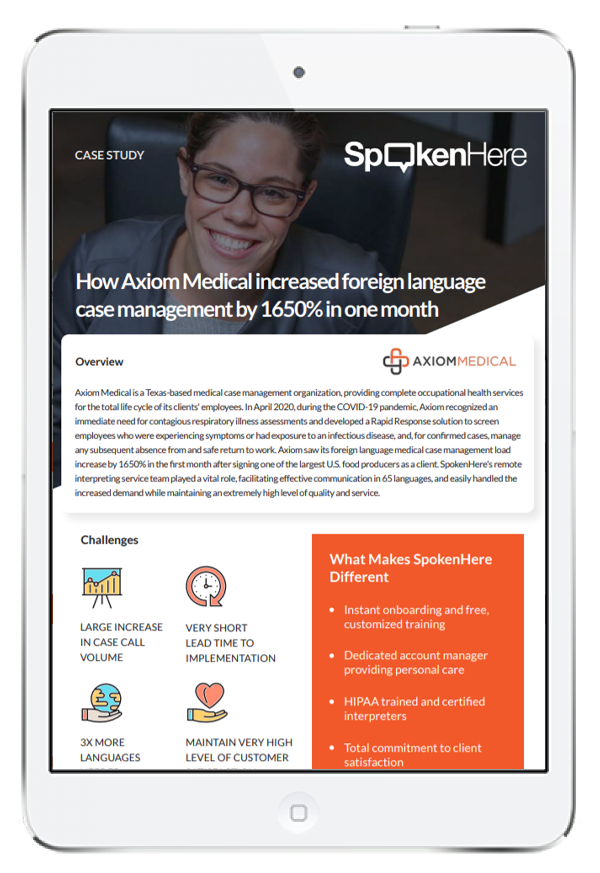
The Risks of Poor or Missing Medical Document Translation
Imagine if you were in a foreign country where you did not know the language, and you needed medical treatment. All of the consent forms given to you are incomprehensible, and there has been no effort put into translating these medical documents. Now imagine if after signing everything in order to get urgent and swift care, you later discover that you had agreed to an amputation – unknowingly of course – for a simple infection when what you really needed were antibiotics. You had not been able to communicate effectively about your needs due to the language barrier. The medical professionals were likewise unable to ascertain what was really going on without your vitally important self-description.
While this specific scenario is not real, versions of this play out in real life on a regular basis.
Without medical document translation and remote interpreters on hand in healthcare settings, language barriers between medical professionals and patients can have consequences ranging from minor mistakes to catastrophic tragedies depending upon the severity of the situation.
90% of healthcare providers did not use competent interpreters
The University of California: Berkeley conducted a study that revealed that among a set of malpractice claims in which language barriers had a direct or indirect impact on the patient’s health outcome, 90 percent of health care providers did not use competent interpreters.
From patient information intake forms to instructions regarding medication dosing, a wide variety of documents are used in medicine, and all of these documents need to be accurate and easily accessible to those who need them. Translating your medical documents and forms poses numerous challenges, but when done well, it can help you better connect with your limited English proficiency (LEP) patients and improve their medical outcomes.
Typical Challenges in Medical Document Translation
Translating medical documents poses a unique set of challenges because of the often technical and sensitive nature of the information included. Because of this, it is critical that your translations are accurate, which needs to be accounted for in multiple areas.
Terminology
Medicine is a very specialized field. Medical terms used in documents must be carefully considered when translating, so they won’t confuse or mislead the reader. It is also important that each document’s specific purpose and audience be considered when translating a medical document to ensure the intended audience will understand the terms and abbreviations used. A professional translation service vets their medical translators to ensure that they are knowledgeable of medical terminology and practices in addition to being experienced translators in the target language.
Dialects / Localization
One word in English could translate into several different terms in another language, and not all words in English have a perfect match in a foreign language. This challenge is compounded when there are different dialects between regions of the same country, and sometimes even between cities and towns in a specific region.
A professional medical document translation service has experienced translators who know the nuances of the target language and locale and are then able to deliver the most accurate, localized translation possible.
Audience
Who is the intended audience of your document? Doctor, nurse, or patient? These questions are crucial, because depending upon who the original document is both from and intended for (doctor to doctor, doctor to patient, patient to nurse, etc.) determines how terms or phrases need to be worded. A professional translation service that vets their medical translators can ensure that they are providing translated medical documents that both meet the needs of the intended audience and convey the message in the most appropriate way for the situation.

6 Common Medical Documents Needing Translation
While this is by no means a complete list of medical documents that LEP patients might benefit from receiving in their native language, these are some of the most important to have professionally translated.
1. Patient Information Forms
Collecting your patients’ personal information is important if you need to be able to confirm their medical coverage, contact other providers, or get in touch with their next of kin. However, for your patients to complete forms accurately, they must be able to easily understand what is being asked, which is much easier in their native language.
2. Patient Instructions
Accurately translated medication instructions are critical to making sure LEP patients remember how to take the correct dose of their medications at the correct time.
It’s also important that patients know exactly what to expect after a procedure and clearly understand what they need to do afterwards to help promote a successful outcome. Providing discharge instructions in multiple languages may also be needed when a patient is referred to home health services, as is common for senior LEP patients. Home healthcare nurses can provide better care if they have access to discharge and medication instructions in both the nurse’s and patient’s native languages.
3. Patient Rights and Responsibilities
Explaining a patient’s rights not only educates and reassures, but helps to keep your clinic or practice free from potential liability. As the United States has become increasingly diverse, the government has created legislation requiring language access for any institution that receives federal funding, even partially or indirectly.
4. Medical History Forms
These questionnaires are important for equipping a patient’s medical team with the essential information they need to make well-informed, accurate diagnoses and to plan appropriate treatments. If these have information that isn’t properly translated – such as allergies or current medication – there could be serious consequences, so it’s vital to use professional medical translators to ensure accuracy.
5. Consent Forms
Consent forms and medical waivers are some of the most important documents used when practicing medicine. Any medical treatment or procedure comes with benefits and potential risks, and it is critical that your patients are able to understand completely and agree to them.
6. Financial Responsibility Forms
It’s very important that your LEP patients clearly understand the details about the costs, insurance coverage, and eligibility of their medical care options, so that they can make informed decisions about their care. Otherwise, they may be unknowingly saddled with a bill that they were not prepared to pay.

Choosing the Right Partner for your Medical Document Translation Needs
An important part of providing the highest level of care for your patients includes translating medical documents and patient forms. It doesn’t have to be a difficult process. Using professional medical translators for your practice’s documents ensures you are communicating effectively with your patients, which, in turn, builds trust and improves patient outcomes.
SpokenHere’s team of professional medical translators provide services to fit all of your medical document translation needs–from basic protocols to pharmaceutical needs and more. Since medical documents are private (HIPAA required), it is important for the translation partner you choose to keep a professional attitude. This is something SpokenHere’s team provides along with sincere empathy for any healthcare related situation. We can also partner with you to establish a medical interpretation program to help you provide the best care possible to your patients.
Contact us today for a consultation.